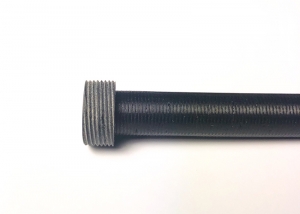hokie
Member
Hi everyone!
I am looking to cast parts for my kitless pens instead of turning raw material to size in order to save a bit of time. I was attracted to liquid diamonds due to its ease of use and apparent ease of turning. However, I'm wondering if anyone else has encountered the threading issue I'm trying to address with liquid diamonds.
After curing for a few days, my casts are nice and hard, unable to be dented with a fingernail, not even close. When I turn my tenon down to size and thread with a die, the threads appear quite rough and the black color goes near white/light gray. The delrin I usually use stays smooth and black after threading, so I'm not sure how to either prevent the phenomenon or fix it after threading.
Here is a picture of what I'm talking about...

If it needs polishing, what is the best way to polish without damaging the threads? If I need to change my casting or threading approach, I'm all ears!
Thanks in advance!
I am looking to cast parts for my kitless pens instead of turning raw material to size in order to save a bit of time. I was attracted to liquid diamonds due to its ease of use and apparent ease of turning. However, I'm wondering if anyone else has encountered the threading issue I'm trying to address with liquid diamonds.
After curing for a few days, my casts are nice and hard, unable to be dented with a fingernail, not even close. When I turn my tenon down to size and thread with a die, the threads appear quite rough and the black color goes near white/light gray. The delrin I usually use stays smooth and black after threading, so I'm not sure how to either prevent the phenomenon or fix it after threading.
Here is a picture of what I'm talking about...

If it needs polishing, what is the best way to polish without damaging the threads? If I need to change my casting or threading approach, I'm all ears!
Thanks in advance!
